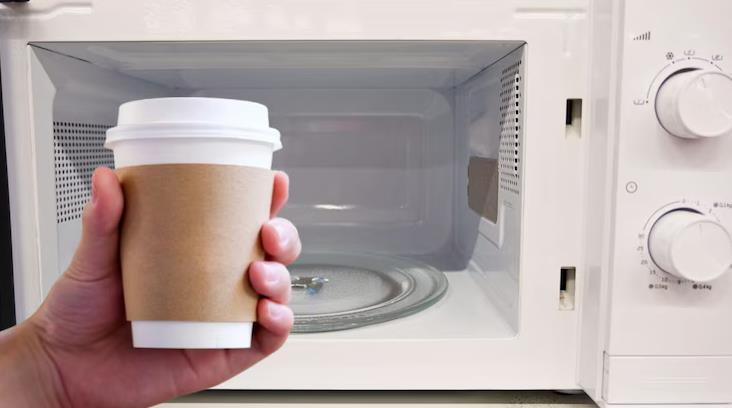
Content Menu
● Understanding Disposable Coffee Cups
>> Composition of Disposable Coffee Cups
● Why Microwaving Disposable Coffee Cups is Risky
● Safe Alternatives for Reheating Coffee
● Tips for Safe Microwaving Practices
● The Environmental Impact of Disposable Cups
>> Sustainable Alternatives
● Consumer Behavior Regarding Disposable vs Reusable Cups
>> Educating Consumers
● Innovations in Cup Design
● Conclusion
● FAQ
>> 1. Can I microwave my paper coffee cup if it has a label saying it's safe?
>> 2. What happens if I microwave a paper coffee cup without checking it first?
>> 3. What should I use instead of a paper cup to reheat my coffee?
>> 4. Are there any types of disposable cups that are safe for microwaving?
>> 5. How can I tell if a paper coffee cup is microwave-safe?
Disposable coffee cups are a ubiquitous part of modern life, especially for those who rely on caffeine to kickstart their day. However, the question of whether it is safe to microwave these cups often arises. This article explores the safety concerns associated with microwaving disposable coffee cups, examines the materials used in their construction, and provides safer alternatives for reheating your beverages.

Understanding Disposable Coffee Cups
Disposable coffee cups are primarily made from paper but often have a plastic or wax lining to prevent leaks. This design is effective for temporary use but raises significant safety concerns when it comes to microwaving.
Composition of Disposable Coffee Cups
- Paper Material: The outer layer is typically made from paper, which is not designed to withstand high microwave temperatures.
- Plastic Lining: Many cups feature a thin plastic lining, often made from polyethylene or polystyrene, which can melt or leach harmful chemicals when heated.
- Wax Coating: Some cups are coated with wax to enhance durability and leak resistance, which can also be affected by heat.
Why Microwaving Disposable Coffee Cups is Risky
Microwaving disposable coffee cups can lead to several problems:
- Chemical Leaching: The heat can cause the plastic lining to break down, potentially releasing harmful chemicals into your drink. Studies have shown that microwaving plastic can accelerate the release of substances like BPA and phthalates, which are linked to various health issues. Research indicates that heating plastic containers can increase the migration of these chemicals into food and beverages, raising concerns about long-term exposure.
- Fire Hazards: Paper is flammable. If the cup overheats, it could catch fire. Microwaves often heat unevenly, creating hot spots that increase this risk. There have been instances where improperly microwaved paper products have ignited due to excessive heat concentration.
- Structural Integrity Loss: The heat can cause the cup to warp or lose its shape, making it difficult to handle and increasing the risk of spills and burns. A warped cup can lead to hot liquid spilling out unexpectedly, resulting in burns or messes.
- Metal Components: Some disposable cups come with lids that may contain metal parts. Microwaving these can lead to sparks and even fires. It's essential to check for any metallic components before placing a cup in the microwave.
Safe Alternatives for Reheating Coffee
Given the risks associated with microwaving disposable coffee cups, consider these safer alternatives:
- Transfer to a Microwave-Safe Mug: The best option is to pour your coffee into a ceramic or glass mug designed for microwave use. This ensures that your drink heats evenly without compromising safety. Look for mugs labeled as microwave-safe; these are specifically tested for high temperatures.
- Use Microwave-Safe Paper Cups: If you must use a paper cup, look for those specifically labeled as microwave-safe. These are designed to withstand higher temperatures without breaking down. However, it's still advisable to monitor them closely while heating.
- Heat on the Stovetop: For larger quantities of coffee, consider reheating it on the stovetop in a saucepan. This method allows for better control over the temperature and prevents overheating. Stovetop heating also provides an opportunity to stir your coffee, ensuring even warmth throughout.
Tips for Safe Microwaving Practices
If you decide to microwave any type of cup (and it's labeled safe), follow these tips:
- Perform a Water Test: Fill the cup with water and microwave it for 30 seconds. If the cup remains cool while the water heats up, it's likely safe to use. This simple test can help you assess whether the material will hold up under heat.
- Avoid Overfilling: Leave some space at the top of the cup to prevent spills and splatters. Overfilling can cause messes in your microwave and increase the risk of burns when removing the cup.
- Use Oven Mitts: Always use oven mitts when handling hot cups to avoid burns. The exterior of even a microwave-safe mug can become very hot during heating.

The Environmental Impact of Disposable Cups
In addition to health concerns, disposable coffee cups contribute significantly to environmental waste. Millions of cups end up in landfills each year due to their composite materials that are difficult to recycle. While some manufacturers are moving towards more sustainable options, such as biodegradable coatings or fully recyclable materials, many still rely on traditional plastic linings that hinder recyclability.
Sustainable Alternatives
To mitigate environmental impact while enjoying your coffee:
- Reusable Coffee Mugs: Investing in a high-quality reusable mug made from stainless steel or glass can significantly reduce waste and provide a safer option for reheating beverages. Many reusable mugs are designed with insulation properties that keep your drinks hot longer without needing reheating.
- Bamboo Fiber Cups: These eco-friendly options are lightweight and biodegradable, making them an excellent alternative for those looking to reduce their carbon footprint. Bamboo fiber cups are often stylish and come in various designs.
- Silicone Cups: Flexible and durable silicone cups are another great alternative that can withstand high temperatures without leaching harmful chemicals. They are often collapsible and easy to carry around.
Consumer Behavior Regarding Disposable vs Reusable Cups
The convenience of disposable coffee cups has led many consumers to favor them over reusable options despite growing awareness about environmental issues. Studies show that while people express concern about waste, convenience often takes precedence when choosing how they consume beverages.
Educating Consumers
To encourage more sustainable choices:
- Awareness Campaigns: Many organizations advocate for reducing single-use plastics through educational campaigns highlighting the environmental impact of disposable products.
- Incentives for Reusables: Some coffee shops offer discounts for customers who bring their own mugs, incentivizing more sustainable behavior among consumers.
Innovations in Cup Design
As awareness grows regarding both health risks and environmental impacts associated with disposable coffee cups, manufacturers are beginning to innovate:
- Biodegradable Materials: New materials made from plant-based substances are being developed that break down more easily than traditional plastics.
- Enhanced Recycling Programs: Some companies are implementing take-back programs where consumers can return used cups for proper recycling or composting.
Conclusion
In summary, while disposable coffee cups offer convenience for on-the-go beverages, they are not suitable for microwaving due to various safety concerns including chemical leaching, fire hazards, and structural integrity loss. The best practice is to transfer your drink into a microwave-safe mug before reheating. By following these guidelines and considering more sustainable options, you can enjoy your coffee safely without risking your health or contributing excessively to environmental waste.

FAQ
1. Can I microwave my paper coffee cup if it has a label saying it's safe?
Yes, if the cup has a “microwave-safe” label, you can microwave it as long as you follow any additional instructions provided by the manufacturer.
2. What happens if I microwave a paper coffee cup without checking it first?
If you microwave a cup that isn't safe, it may melt or leak chemicals into your drink or even catch fire due to overheating or flammable materials present in the cup.
3. What should I use instead of a paper cup to reheat my coffee?
It's best to use a ceramic or glass mug specifically designed for microwave use as these materials do not pose risks associated with heating plastics or waxes.
4. Are there any types of disposable cups that are safe for microwaving?
Yes, some manufacturers produce microwave-safe paper cups specifically designed for this purpose; however, most traditional disposable coffee cups are not intended for microwaving due to their materials.
5. How can I tell if a paper coffee cup is microwave-safe?
Check for any markings or symbols on the cup itself indicating that it is safe for microwave use; if there are no clear labels or instructions available, it's best not to microwave it.

















